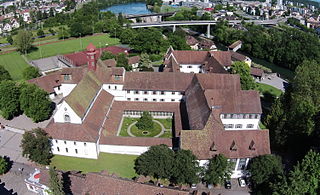
The canton of Bern, or Berne, is one of the 26 cantons forming the Swiss Confederation. Its capital city, Bern, is also the de facto capital of Switzerland. The bear is the heraldic symbol of the canton, displayed on a red-yellow background.

Wurmsbach Abbey is a monastery of Cistercian nuns located in Bollingen, a locality of Rapperswil-Jona, in the Canton of St. Gallen, Switzerland. It is located on the north shore of upper Lake Zürich. The house is a part of the Order of Cistercians of the Common Observance (O.Cist.).

Wettingen Abbey was a Cistercian monastery in Wettingen in the Swiss canton of Aargau. It was founded in 1227 and dissolved during the secularisation of 1841, but re-founded at Mehrerau in Austria in 1854. The buildings are listed as a heritage site of national significance.

Wettingen-Mehrerau Abbey is a Cistercian territorial abbey and cathedral located at Mehrerau on the outskirts of Bregenz in Vorarlberg, Austria. Wettingen-Mehrerau Abbey is directly subordinate to the Holy See and thus forms no part of the Catholic Archdiocese of Salzburg. The abbot of Wettingen-Mehrerau, however, is a member of the Austrian Bishops' Conference. The official name of the abbey is Beatae Mariae Virginis de Maris Stella et de Augia Majore.

Wynigen is a municipality in the administrative district of Emmental in the canton of Bern in Switzerland.

Fraubrunnen is a municipality in the Bern-Mittelland administrative district in the canton of Bern in Switzerland. On 1 January 2014 the former municipalities of Büren zum Hof, Etzelkofen, Grafenried, Limpach, Mülchi, Schalunen and Zauggenried merged into the municipality of Fraubrunnen.

Jegenstorf is a municipality in the Bern-Mittelland administrative district in the canton of Bern in Switzerland. On 1 January 2010 the former municipality of Ballmoos merged into Jegenstorf and on 1 January 2014 Münchringen and Scheunen merged into Jegenstorf.

Limpach is a former municipality in the Bern-Mittelland administrative district in the canton of Bern in Switzerland. On 1 January 2014 the former municipalities of Limpach, Büren zum Hof, Etzelkofen, Grafenried, Mülchi, Schalunen and Zauggenried merged into the municipality of Fraubrunnen.

Heggbach Abbey was a Cistercian nunnery in Heggbach, now part of the municipality of Maselheim in the district of Biberach, Baden-Württemberg, Germany.

La Maigrauge Abbey or Magerau Abbey is a monastery of Cistercian nuns located in Fribourg, Switzerland, and founded in 1255. The abbey is situated on the Sarine River and lies on the border between French-speaking and German-speaking Switzerland. The community is bilingual.
The Kyburg family was a noble family of grafen (counts) in the Duchy of Swabia, a cadet line of the counts of Dillingen, who in the late 12th and early 13th centuries ruled the County of Kyburg, corresponding to much of what is now Northeastern Switzerland.

Kasteln Castle is a castle in the municipality of Oberflachs in Canton Aargau, Switzerland. It is located west of the village on a rocky outcrop, surrounded by vineyards and woods. Today, it serves as a boarding school for students with behavioral problems. The immediately adjacent castle Ruchenstein was demolished in 1643, when the small fort was rebuilt into a Schloss Kasteln.

The Burgdorferkrieg or Kyburgerkrieg was a war in 1383-84 between the counts of Neu-Kyburg and the city of Bern for supremacy in the County of Burgundy in what is now Switzerland.

Frienisberg Abbey is a former Cistercian religious house in the Swiss municipality of Seedorf in the Canton of Bern.

Töss Monastery was a community of Dominican nuns located in the former Swiss city of Töss, now a part of Winterthur. Nothing of the original buildings exists today.

Tänikon Abbey is a former Cistercian nunnery in the village of Ettenhausen in the municipality of Aadorf in the canton of Thurgau in Switzerland. The former abbey church and the conventual buildings, now Agrotechnorama Tänikon, are both Swiss heritage sites of national significance.

Rüegsau Priory was a 12th-century Swiss monastery of Benedictine nuns in Rüegsau, in the Canton of Bern. It was dissolved in 1528 as a result of the Reformation in Switzerland.

Trub Abbey is a former Benedictine monastery in the municipality of Trub in Bern Switzerland

Eschenbach Abbey is a community of Cistercian nuns in Eschenbach in Lucerne, Switzerland. The abbey was founded in about 1290 for Augustinian nuns, and became Cistercian in 1588.


















